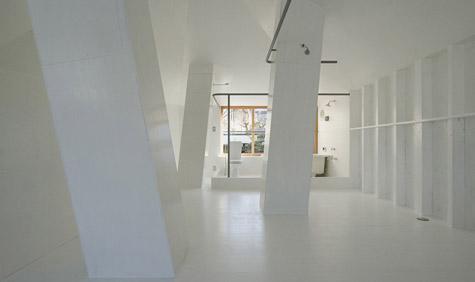Interactive floorplan: Light Well House, Kyoto

This exquisite private house in Kyoto brings together two key concerns of the contemporary Japanese architect: space and light.
Unlike earlier residential projects by Keiichi Hayashi, like the UK house and House for a Couple, the proposed site for the Light Well House was small and hemmed in. This left little space for the long, linear floorplan that characterized his earlier residential projects.
Mindful that both light and space were at a serious premium, 41-year-old architect Keiichi Hayashi has instead placed functions in a vertical stack, drawing light straight through each storey via a series of tubes. A development of the 2005 House on the Mountainside in Hyogo - another stacked structure - the brown metal Light Well House is insular and withdrawn from its surroundings, while creating a generous inner world.

See more images of Lightwell House
The clients – a young couple and their child – had to accept certain preconditions, such as the volume of the house – automatically defined by local building laws. The architect ensured the house was at the centre of the site in order to create two open spaces to the east, where there is a small courtyard, and the west, the entrance elevation facing onto the narrow lane. Each floor is treated as an open plan space, with the light tubes acting as dividers to help shape the floorplan and influence the placing of furniture and activities.
The ground floor contains a living and dining room space, with bedroom and bathroom on the floor above, next to an 'inner terrace', a place for drying clothes and plants.
Hayashi has thought of everything. Not only do the light tubes act as funnels for daylight, they also double up as the structural supports for the house, a set of angular braces that give the upper storey a crazed, expressionist atmosphere. From the ground floor, each 'randomly placed' light well provides a tantalizing glimpse of blue sky.
Wallpaper* Newsletter
Receive our daily digest of inspiration, escapism and design stories from around the world direct to your inbox.
The combination of open space and random enclosure demonstrates Hayashi's particular approach. 'To understand the space of the house, I thought of a space in a forest and a space in a grassland,' says Hayashi, 'there are many trees in a forest, and when people are there, these trees will become clues or reference points to create activities.' Rather than the unbounded space of the grassland, the Light Well House has its own set of rules.
'Although the light wells might be thought of as obstacles, I think of them like trees in a forest, creating unexpectedly flexible and free space,' Hayashi muses, adding that 'I wish that this will give the residents the joy of life.' Noble sentiments for a modest house.
Ellie Stathaki is the Architecture & Environment Director at Wallpaper*. She trained as an architect at the Aristotle University of Thessaloniki in Greece and studied architectural history at the Bartlett in London. Now an established journalist, she has been a member of the Wallpaper* team since 2006, visiting buildings across the globe and interviewing leading architects such as Tadao Ando and Rem Koolhaas. Ellie has also taken part in judging panels, moderated events, curated shows and contributed in books, such as The Contemporary House (Thames & Hudson, 2018), Glenn Sestig Architecture Diary (2020) and House London (2022).
-
 All-In is the Paris-based label making full-force fashion for main character dressing
All-In is the Paris-based label making full-force fashion for main character dressingPart of our monthly Uprising series, Wallpaper* meets Benjamin Barron and Bror August Vestbø of All-In, the LVMH Prize-nominated label which bases its collections on a riotous cast of characters – real and imagined
By Orla Brennan
-
 Maserati joins forces with Giorgetti for a turbo-charged relationship
Maserati joins forces with Giorgetti for a turbo-charged relationshipAnnouncing their marriage during Milan Design Week, the brands unveiled a collection, a car and a long term commitment
By Hugo Macdonald
-
 Through an innovative new training program, Poltrona Frau aims to safeguard Italian craft
Through an innovative new training program, Poltrona Frau aims to safeguard Italian craftThe heritage furniture manufacturer is training a new generation of leather artisans
By Cristina Kiran Piotti